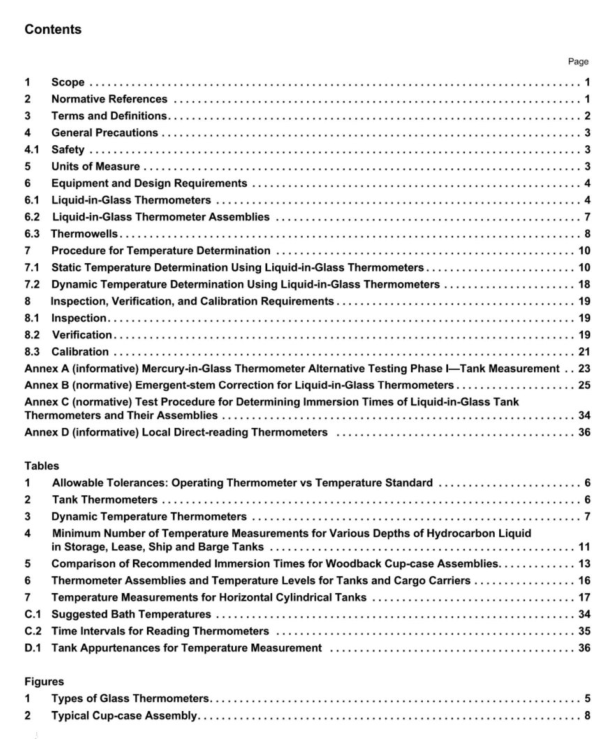API MPMS7.1 pdf download

API MPMS7.1 pdf download Manual of Petroleum Measurement Standards , Chapter 7.1 Temperature Determination- Liquid-in-Glass Thermometers
4 General Precautions
4.1 Safety Safety sha ll be cons id ered for the specificat ion , installat ion and operati on of all equipmen t. Refer to API RP 500 and NF PA 70 for guidan ce. When loading li qu ids that ca n accumulate static charges , refer to the precautions desc ri bed in the International Safety Guide for Oil Tankers and of Li fe at Sea, AP I MPMS Chapter 3 , and A PI RP 2003. Care must be taken with thermometers to prevent breakage , wh i ch will result in a safety hazard. If the li q uid in t he thermometer is mercury , must be taken.
4.1 .1 MercuryWarning WARNING: Mercury has been designated by the Environmental Protection Agency (EPA) and many state agencies as a hazardous material that can cause central nervous system, kidney and liver damage. Mercury or its vapor , may be hazardous to health and corrosive to materials. Caution should be taken when handling mercury and mercury containing products. See the applicable product Safety Oata Sheet (SOS) or Material Safety Oata Sheet (MSOS) for details, and the EPA website http: //www .epa.gov/mercury/faq. htm for additional information. Users should be aware that selling mercury or products containing mercury , or both , in your state may be prohibited by state law .
5 Units of Measure Fo r custody tra nsfer , the means of temperature determination shou ld be agreed to among the parties involved Temperatur es referen ced in this docu me nt are those defin ed by t he In te rn at io na l Temperatu re scale of 19 90 (ITS-90). Temperatur es may be measur ed and expressed in degrees Ce lsi us or in degrees Fahrenh ei t. Th is standard presents implemented. The presentations of both units are for the convenience of the user and are not necessarily exact conversions. The units of implementation are typically determined by contract , regulatory requirement , the or the user’s calibration program. Once a system of units is chosen for a given application , it should not be arbitrarily changed. (See API MPMS Chapter 15 .)
6 Equipment and Design Requirements
6.1 Li quid-in-Glass Thermometers
6.1 .1 General Information Du e to the identified hazards associated with mercury- in ..g lass thermometers (MIGTs) , its use is being phased ou t. API , in collaboration with the U.S . Environmental Protection Agency , conducted a comparison study of MIGTs to other liquid-in-glass and digital thermometers in order to provide a comparison of the accuracies of each type of device Th e testing indicated that altemative thermometers meeting the requirements in ASTM E2251 can be substituted for MIGTs . Annex A provides additional details of the testing that was conducted.
6.1 .1.1 Thermometer Specifications Glass thermometers include total-immersion thermometers and thermometers (see Figure 1 and refer to ASTM E344). These th ermometers should conform to the specifications in ASTM E1 or E2251 for thermometers , or to the National lnstitute of Standards and Technology (NIST) specifications.
Calibration does not have to be done by a national metrology institute (NMI) (e . g. NIST in the United States) , but the certified instruments used for the calibration shall be traceable to a NMl ASTM thermometers are designed to be ei th er total immersion (thermometer immersed in the medium to be measured to the top of the thermometer liquid column) or immersion (thermometer in the medium to be measured to a specific depth marked on the thermometer). Tank thermometers used in conjunction with a cup-case assembly are total-immersion thermometers that are completely immersed into the tank but only a portion of the thermometer is immersed in the cup when read. Testing has shown that the accuracy of the reading is not when read quickly after being raised out of the tank. Operating thermometers that are used in static or dynamic measurement shall be compared on a regular basis (see Section 8) to a temperature standard. The recommended allowable tolerances between the operating thermometer and the NMI traceable thermometer are shown in Table 1 , and are provided as a reference for limits consider ed acceptable for static and dynamic temperature determinations in custody transfer measurement of petroleum and petroleum products
6.1 .1.2 Permanent Glass Thermometers Securely mount permanently installed glass thermometers in a thermowell and protect from breakage by the us e of a housing. They shall have the same high resolution scale graduation interval and tolerance as glass test thermometers. These thermometers shall be calibrated and checked using test thermometers as described in Section 8.
6.1 .1.3 Tank Thermometers Tank thermometers shall be of the total immersion type and shall be made in accordance with the in ASTM E1 or E2251. Each thermometer shall be the liquid-in-glass type with nitrogen or another suitable inert gas filling the space above the liquid column , and with graduation marks permanently etched on its glass stem. Angle- stem thermometers may use a separate graduated scale , as discussed in 6.2.3. The thermometers listed in Table 2 shall be used









